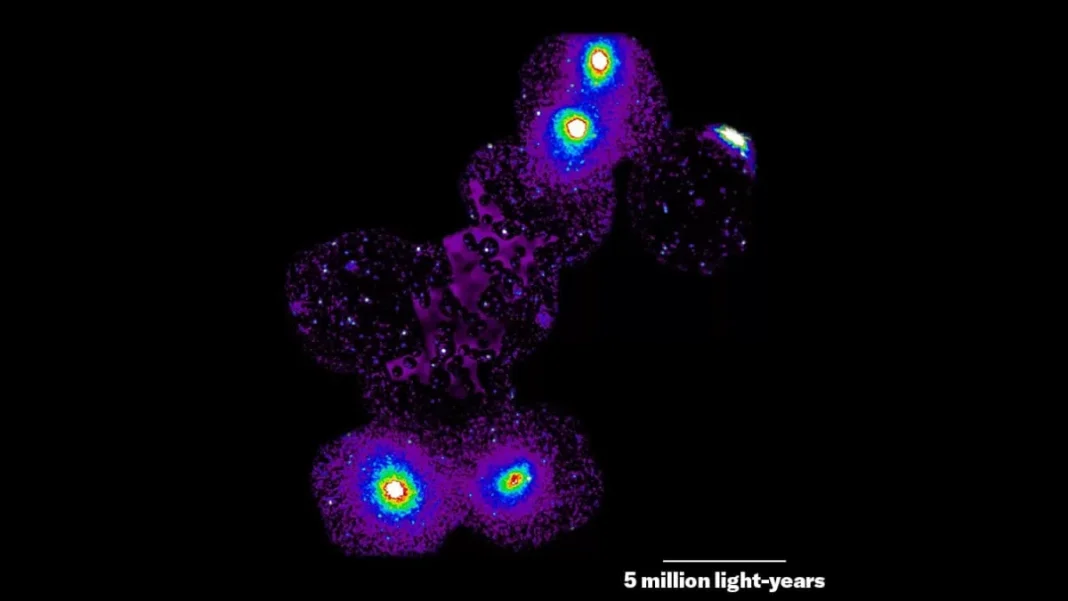New Astronomical Breakthroughs Reveal the Universe’s Hidden Ordinary Matter
The vast expanse of the universe has always been a source of fascination and wonder for humanity. For centuries, we have been trying to unravel its mysteries and understand the secrets it holds. And now, thanks to new astronomical breakthroughs, we are one step closer to unlocking the secrets of the universe.
In a recent study, scientists have identified the location of the universe’s “missing” ordinary matter. This discovery has been made possible by using 70 Fast Radio Bursts (FRBs), including one from a galaxy 9 billion light-years away. These FRBs are intense bursts of radio waves that last only a few milliseconds and are believed to originate from distant galaxies.
The study, conducted by an international team of researchers, has revealed that 76% of the universe’s ordinary matter exists between galaxies. This finding is a significant breakthrough as it has long been a mystery as to where this matter, which makes up about 5% of the universe, was hiding.
Ordinary matter, also known as baryonic matter, is the material that makes up stars, planets, and all visible objects in the universe. However, until now, scientists have only been able to account for about half of the expected amount of ordinary matter in the universe. The rest has been deemed “missing” or “dark.”
But with the help of FRBs, scientists have been able to detect the faint radio signals emitted by this matter, allowing them to map its distribution in the universe. The team used a technique called “delayed dispersion,” which measures the delay in the arrival time of the radio waves to determine the amount of matter they have passed through.
The results of the study have been published in the journal Nature, and they shed new light on the structure of the universe. It has been found that the ordinary matter is not evenly distributed throughout the universe, as previously thought. Instead, it is concentrated in filaments that connect galaxies, forming a vast cosmic web.
But that’s not all. In a separate study, scientists have also observed an enormous hot gas filament connecting galaxy clusters. This filament, which is about 50 million light-years long, is the largest ever seen and is believed to be the hottest and most massive structure in the universe.
The discovery was made using the European Space Agency’s XMM-Newton X-ray telescope, which detected the high-energy X-rays emitted by the gas. This finding provides further evidence for the existence of the cosmic web, a network of filaments that connect galaxies and galaxy clusters.
The cosmic web is a crucial component of the structure of the universe, and its discovery has been a major breakthrough in our understanding of the cosmos. It is believed that the filaments of the cosmic web act as highways for the flow of matter and energy, shaping the evolution of galaxies and the universe itself.
These new astronomical breakthroughs have opened up a whole new world of possibilities for scientists. They have not only helped us locate the missing ordinary matter but have also given us a glimpse into the complex and intricate structure of the universe.
The discovery of the cosmic web and the mapping of the universe’s ordinary matter have also provided valuable insights into the nature of dark matter and dark energy, which make up the remaining 95% of the universe. It is hoped that these findings will help us unravel the mysteries of these elusive components and bring us closer to a complete understanding of the universe.
The implications of these breakthroughs go beyond the realm of astronomy. They have the potential to impact our daily lives as well. The knowledge gained from these studies can help us develop new technologies and innovations that can benefit humanity in various ways.
The universe is a vast and mysterious place, and there is still so much we have yet to discover. But with each new breakthrough, we are getting closer to unlocking its secrets. These latest findings are a testament to the power of human curiosity and the endless possibilities of scientific exploration.
As we continue to push the boundaries of our knowledge, let us be inspired by these new astronomical breakthroughs and continue to explore the wonders of the universe. Who knows what other mysteries and wonders await us in the vast expanse of space?


